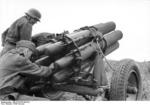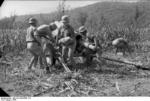15 cm NbW 41 Launcher
| Country of Origin | Germany |
| Type | Launcher |
| Caliber | 150.000 mm |
| Weight | 1130.000 kg |
| Rate of Fire | 4 rounds/min |
| Range | 1.925 km |
| Muzzle Velocity | 145 m/s |
Contributor: Alan Chanter
ww2dbaseIn 1930 the German General Staff had spotted a loophole in the Versailles treaty; they were effectively forbidden to develop heavy artillery but the treaty said nothing about rockets. The rocket research station of the army weapons office at Kummersdorf near Berlin, Germany was set up to take advantage of this, and one of the projects handed to them was the development of a bombardment weapon with a range of between three and five miles. In later years their primary interest became the perfection of liquid-fuel rockets, culminating in the famous V2 rocket, but before this the Research station did a lot of fundamental research into rocket ballistics and solid fuel motors.One field of investigation was the question of stabilizing rockets in flight by spinning them, rather than by using the more usual fins. Early research into this had been by the British army's "Hales War rocket" in the 1870s, and then by the Swedish inventor Baron Unge, but nobody had much faith in the idea and it had lapsed into the limbo of forgotten weapons. The Kummersdorf team, under the guidance of Colonel Walther R. A. Dornberger (probably assisted by another Kummersdorf luminary, Dr. Wernher von Braun), looked afresh at the spin-stabilized rocket and perfected a new design. The drawback with all previous rocket designs had been that the thrust was produced at the tail-end of the rocket, and this tended to push the nose off course if the motor burned at all erratically, which it often did. In addition the rate of spin had never been scientifically worked out to produce the best results.
Dornberger's team changed all this. Their first move was to put the rocket motor at the front of the assembly and place the explosive-packed "warhead" behind it. The rocket blast exhausted just behind the mid point of the assembly, in front of the centre of gravity, so that the rocket was now pulling the payload instead of pushing it. Instead of a simple jet pipe, the rocket blast was released through a ring of 26 venturi tubes surrounding the rocket body which were canted at an angle of 14° to the axis of the motor so that their thrust not only propelled the rocket but also had sufficient angular velocity to generate a rapid rate of spin. The result was one of the most accurate small rockets yet created. The next task was to ally it to a suitable launching device and so turn it into a practical weapon.
The 1,195-pound launcher was relatively simple - a cluster of six tubes mounted on the light, two-wheeled split-trail carriage which had originally been designed for the infantry's 37-millimeter Pak 36 anti-tank gun. It fired six 76-pound 150-millimeter rockets each carrying 5.62 pounds of high explosive to a maximum range of 7,545 yards. The launcher could be quickly reloaded in 90 seconds so as to be able to fire three six-rocket volleys every five minutes, with each tube firing separately to avoid overturning the carriage. With the launcher loaded the four-man crew took cover 10-15 yards away so as to be clear of the blast and discharged the rockets electronically through a magneto linked to igniters on the firing tubes. The rockets could be fired either singly or, more commonly, in an automatic volley at two second intervals so that the flight of one rocket did not disturb the launch of the next. The accuracy, whilst not as good as that of a conventional gun, was certainly better than any previous rocket had achieved and better than most mortars could manage.
Between 1941 and 1945, 345 examples of 15 cm Nebelwerfer 41 were built.
The 15 cm Nebelwerfer 41 launcher, as employed by the first three mortar (Werfer) regiments (51st, 52nd and 53rd) was highly successful on the eastern front and the Germans managed to keep it a secret for a surprisingly long time. Soviet soldiers frequently reported a strange new weapon whose shells made a peculiar shrieking noise as they passed overhead. Eventually, at the capture of Velikiye-Luki, Russia in Jan 1943, the Red Army captured some Nebelwerfer launchers together with some ammunition and the secret was out. Since the Soviets were already using rockets of their own, the discovery that the German mystery weapon was, after all, just another rocket, went a long way towards dispelling some of the more fanciful rumours circulating among the troops.
On 6 Mar 1943, the 71st Werfer Regiment supported Field Marshal Erwin Rommel's disastrous tank attack on the Eighth Army at Medenine in Tunisia. Personally brought forwards by Oberstleutnant Count von Stauffenberg (who would at a later date be responsible for the notorious bomb plot Against Hitler), the regiment's three batteries were rapidly knocked out by British fighter-bombers. Concealment of Nebelwerfer launchers was the principle drawback. Although only one-third the weight of a conventional field artillery piece, the Nebelwerfer launcher kicked up so much dust during firing that frequent changes of camouflaged positions was needed to avoid retaliatory fire. Shortly after this the British Army captured their first Nebelwerfer launcher. During the Tunisian campaign it did not make the same impression as it had in Russia. A British report in May 1943 said: "Reports of this weapon in battle speak of it as noisy but having only limited fragmentation and blast effect, and state that no effects have been felt by a man standing 60 yards from the burst." ww2dbase
Last Major Revision: Nov 2011
Photographs
 |  |  |  |
15 cm NbW 41 Timeline
| 20 Feb 1943 | The Germans made the first use of their new 15 cm Nebelwerfer 41 rocket launcher against the western allies at Kasserine Pass in Tunisia. |
| 6 Mar 1943 | The German 71st Werfer Regiment went into action in support of Field Marshal Rommel's disastrous tank attack on the Eighth Army at Medenine in Tunisia. Personally brought forward by Oberstleutnant (Lieutenant Colonel) Count Claus von Stauffenberg, later organizer of the 1944 bomb plot against Hitler, the regiment's three batteries were rapidly knocked out by Allied fighter bombers-the dust thrown up by the launching of the Nebelwerfer rockets having revealed their camouflaged positions. |
Please consider supporting us on Patreon. Even $1 per month will go a long way! Thank you. Please help us spread the word: Stay updated with WW2DB: |
Search WW2DB

News
- » Wreck of Teruzuki Found (27 Jul 2025)
- » USS Orlean's Bow Found (22 Jul 2025)
- » The Emperor of Japan Planned to Honor WW2-era Japanese POWs in Mongolia (4 Jul 2025)
- » US State Lawmaker John Winter Caught Using Racial Slur "Jap" and Apologized (11 Jun 2025)
- » US Government Plans to Purge WW2 Information (17 Mar 2025)
- » See all news
Current Site Statistics
- » 1,181 biographies
- » 337 events
- » 45,132 timeline entries
- » 1,249 ships
- » 350 aircraft models
- » 207 vehicle models
- » 376 weapon models
- » 123 historical documents
- » 261 facilities
- » 470 book reviews
- » 28,426 photos
- » 365 maps
Famous WW2 Quote
"An appeaser is one who feeds a crocodile, hoping it will eat him last."Winston Churchill
Support Us
Please consider supporting us on Patreon. Even $1 a month will go a long way. Thank you!
Or, please support us by purchasing some WW2DB merchandise at TeeSpring, Thank you!